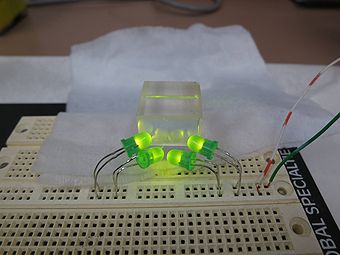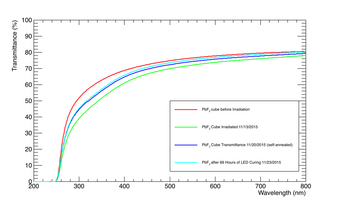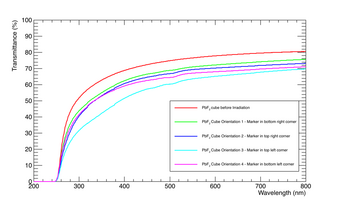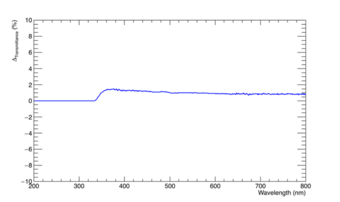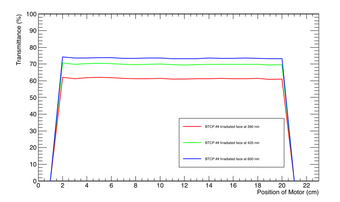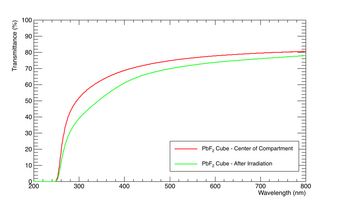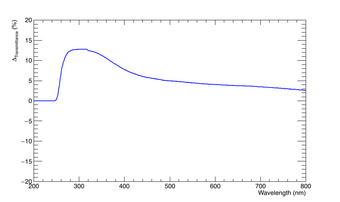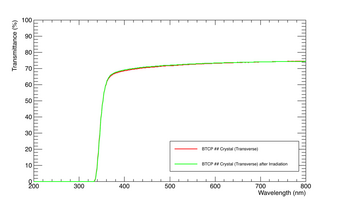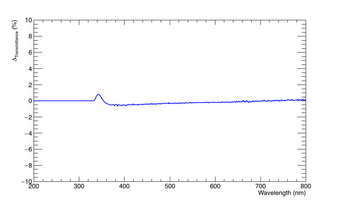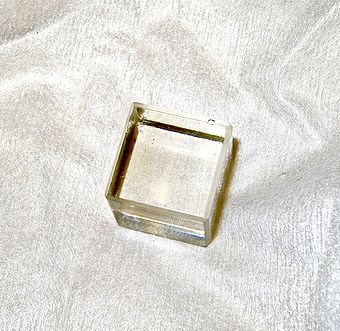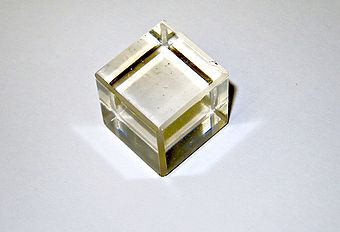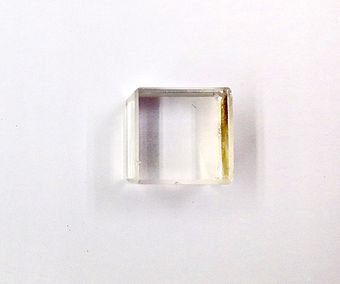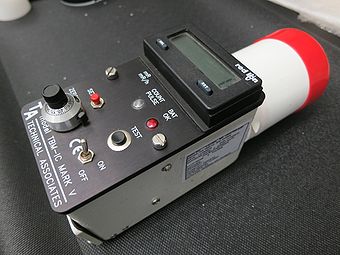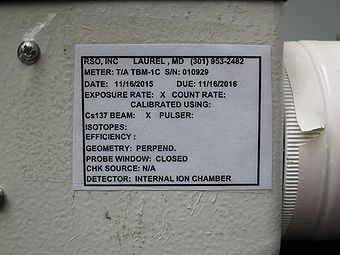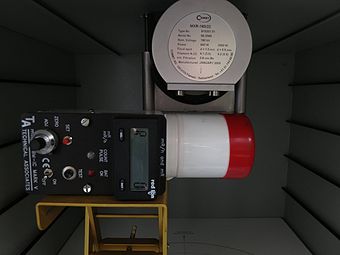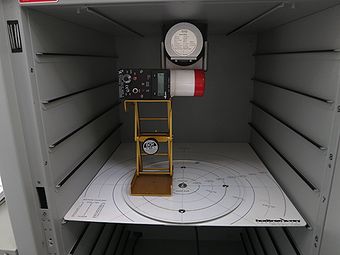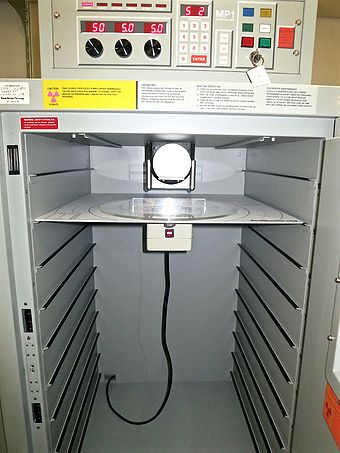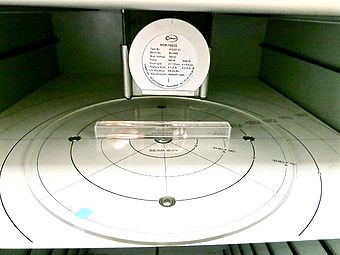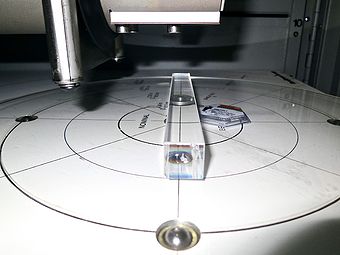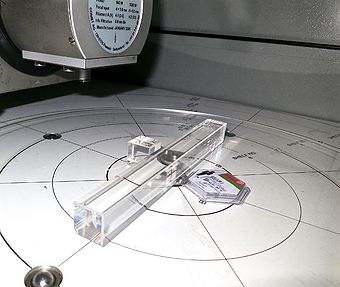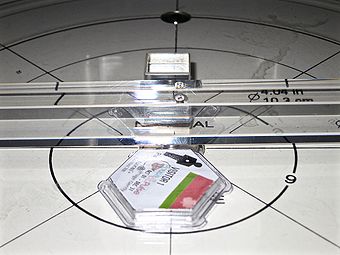Difference between revisions of "MainPage:Nuclear:NPS:PWO:Hardness"
| (21 intermediate revisions by 2 users not shown) | |||
| Line 4: | Line 4: | ||
| <font size="2">'''[[MainPage:Nuclear|⇐ Back to the Main_Page]]'''</font> | | <font size="2">'''[[MainPage:Nuclear|⇐ Back to the Main_Page]]'''</font> | ||
|} | |} | ||
| + | |||
| + | == Dose == | ||
| + | |||
| + | When irradiating the crystals, the dose collected in them is the total energy absorbed per unit mass of material. In order to prepare an irradiation experiment, the dose rate can be estimated as | ||
| + | |||
| + | {| border="0" style="text-align:center;" width="100%" | ||
| + | |+ | ||
| + | |- | ||
| + | | valign="top"| [[File:doseRate.png|center|x100px]] | ||
| + | |} | ||
| + | |||
| + | In this equation, | ||
| + | |||
| + | {| border="0" width="80%" | ||
| + | |+ | ||
| + | |- | ||
| + | | width="30%"| [[File:activityBq.png|center|x50px]] | ||
| + | | width="70%"| is the activity of the source, in Bq (number of disintegrations per second); | ||
| + | |- | ||
| + | | [[File:DeltaOmega.png|center|x50px]] | ||
| + | | is the fractional solid angle covered by the sample (this ranges from 0 to 1, depending on the setup); | ||
| + | |- | ||
| + | | [[File:EGamma.png|center|x50px]] | ||
| + | | is the energy of each gamma rays emitted in the decay; | ||
| + | |- | ||
| + | | [[File:CGammaAbs.png|center|x50px]] | ||
| + | | is the absorption coefficient, i.e., the fraction of the gammas that will be absorbed by the sample; | ||
| + | |- | ||
| + | | [[File:AbsLen.png|center|x50px]] | ||
| + | | is the mass absorption coefficient of the sample; | ||
| + | |- | ||
| + | | [[File:sampleThick.png|center|x50px]] | ||
| + | | is the thickness the sample; | ||
| + | |- | ||
| + | | [[File:sampleRho.png|center|x50px]] | ||
| + | | is the density of the sample; | ||
| + | |- | ||
| + | | [[File:Msample.png|center|x50px]] | ||
| + | | is the mass of sample effectively being irradiated; | ||
| + | |} | ||
| + | |||
| + | Considering the irradiation setup at CUA with Co-60, the gammas have 1.17 and 1.33 MeV (mass absorption coefficients of 0.05832 and 0.05365 cm2/g respectively), irradiating a cylindrical section of the crystal with 1 inch in diameter and 2 centimeter thickness with a fractional solid angle of about 1/3, and crystal's density of 8.28 g/cm3: | ||
| + | |||
| + | [[File:doseRate2.png|center|x100px]] | ||
| + | |||
| + | [[File:doseRate3.png|center|x100px]] | ||
=== Thermal Annealing === | === Thermal Annealing === | ||
| Line 27: | Line 73: | ||
|- | |- | ||
| valign="top"| [[File:Cube 5.png|thumb|center|340px|Transmittance of the PbF2 crystal before irradiation (red), after irradiation on 11/13 (green), after one week -self-annealed on 11/20 (dark blue), and after LED curing for 69 hours on 11/23 (teal).]] | | valign="top"| [[File:Cube 5.png|thumb|center|340px|Transmittance of the PbF2 crystal before irradiation (red), after irradiation on 11/13 (green), after one week -self-annealed on 11/20 (dark blue), and after LED curing for 69 hours on 11/23 (teal).]] | ||
| + | | valign="top"| [[File:Cube 1209015 both.png|thumb|center|340px|Graph showing the transmittance of the PbF2 cube that was a part of LED curing after several days, compared with the cube before irradiation (red). The cube surface that the LED light was focused on was marked (initially on the bottom right), and oriented to account for a total of four different locations of the beam on the cured surface.]] | ||
|} | |} | ||
| Line 35: | Line 82: | ||
During the irradiation the crystal was observed to scintillate. | During the irradiation the crystal was observed to scintillate. | ||
| − | + | == Error history == | |
| + | 7/18/17-- Error=E1 appeared immediately after machine finished warming up. Did not automatically allow manual entering of keV/mA/time. Solution= type program "2" in and enter keV/mA/time. | ||
=== Results === | === Results === | ||
| Line 60: | Line 108: | ||
[http://www.vsl.cua.edu/cua_phy/images/1/1e/BTCP_after11202015_xray.pdf Optical transmittance after irradiation (numerical values)] | [http://www.vsl.cua.edu/cua_phy/images/1/1e/BTCP_after11202015_xray.pdf Optical transmittance after irradiation (numerical values)] | ||
| + | |||
| + | {| border="0" style="text-align:center;" width="100%" | ||
| + | |+ | ||
| + | |- | ||
| + | | valign="top"| [[File:Transvsposbtcp.png|thumb|center|340px|Graph of Transmittance (%) vs. Position (cm) showing transmittance of BTCP crystal through the irradiated face at three different wavelengths: 360 nm (red), 420 nm (green), and 600 nm (blue). These wavelengths correspond to the different positions (in cm) of the motor in which the crystal was placed on top of.]] | ||
| + | |} | ||
| + | |||
| + | == Irradiation of PbF2 Crystal == | ||
| + | |||
| + | We were able to see visual and statistical evidence of irradiation on the PbF2 crystal. | ||
| + | |||
| + | ===Results=== | ||
| + | |||
| + | |||
| + | {| border="0" style="text-align:center;" width="100%" | ||
| + | |+ | ||
| + | |- | ||
| + | | valign="top"| [[File:Pbf2beforeandafterirrad.png|thumb|center|340px|Graph comparing two measurements of Transmittance (%) vs. Wavelength (nm) of PbF2 crystal cube before irradiation (red) and after irradiation (green) centered at the sample compartment.]] | ||
| + | | valign="top"| [[File:DIFF pbf2cubebeforeandafterirrad.png|thumb|center|340px|Graph showing the difference between the two measurements of the PbF2 crystal cube.]] | ||
| + | |+ | ||
| + | |- | ||
| + | | valign="top"| [[File:BTCP before and after irrad.png|thumb|center|340px|Graph comparing two measurements of Transmittance (%) vs. Wavelength (nm) of BTCP ## crystal before irradiation (red) and after irradiation (green) centered at the sample compartment.]] | ||
| + | | valign="top"| [[File:Diff BTCP before and after irrad.png|thumb|center|340px|Graph showing the difference between the two measurements of the BTCP ## crystal before and after irradiation.]] | ||
| + | |} | ||
| + | |||
| + | {| border="0" style="text-align:center;" width="100%" | ||
| + | |+ | ||
| + | |- | ||
| + | | valign="top"| [[File:Cube irradiated 3.jpg|thumb|center|340px|PbF2 cube showing brownish-tint on one surface, indicative of irradiation.]] | ||
| + | | valign="top"| [[File:Cube irradiated 1.jpg|thumb|center|340px|Another view of the PbF2 cube after irradiation.]] | ||
| + | |} | ||
| + | {| border="0" style="text-align:center;" width="100%" | ||
| + | |+ | ||
| + | |- | ||
| + | | valign="top"| [[File:Cube irradiated 2.jpg|thumb|center|340px|Another view of the PbF2 cube after irradiation.]] | ||
| + | |} | ||
== Dose Rate Measurements == | == Dose Rate Measurements == | ||
| Line 195: | Line 279: | ||
| valign="top"| [[File:Irrad cube and crystal dosimeter.jpg|thumb|center|340px|A picture showing the BTCP ##, PbF2 crystal and dosimeter aligned at the center of the beam.]] | | valign="top"| [[File:Irrad cube and crystal dosimeter.jpg|thumb|center|340px|A picture showing the BTCP ##, PbF2 crystal and dosimeter aligned at the center of the beam.]] | ||
| valign="top"| [[File:Irrad cube crystal dosimeter close view.jpg|thumb|center|340px|A close-up picture of the BTCP ##, PbF2 crystal and dosimeter aligned at the center of the beam.]] | | valign="top"| [[File:Irrad cube crystal dosimeter close view.jpg|thumb|center|340px|A close-up picture of the BTCP ##, PbF2 crystal and dosimeter aligned at the center of the beam.]] | ||
| − | |||
| − | |||
| − | |||
| − | |||
| − | |||
| − | |||
| − | |||
| − | |||
| − | |||
| − | |||
| − | |||
| − | |||
| − | |||
| − | |||
| − | |||
| − | |||
| − | |||
| − | |||
| − | |||
| − | |||
| − | |||
| − | |||
| − | |||
| − | |||
| − | |||
| − | |||
| − | |||
|} | |} | ||
Latest revision as of 16:50, 31 July 2017
| ⇐ Back to Neutral Particle Spectrometer |
| ⇐ Back to the Main_Page |
Dose
When irradiating the crystals, the dose collected in them is the total energy absorbed per unit mass of material. In order to prepare an irradiation experiment, the dose rate can be estimated as
In this equation,
| is the activity of the source, in Bq (number of disintegrations per second); | |
| is the fractional solid angle covered by the sample (this ranges from 0 to 1, depending on the setup); | |
| is the energy of each gamma rays emitted in the decay; | |
| is the absorption coefficient, i.e., the fraction of the gammas that will be absorbed by the sample; | |
| is the mass absorption coefficient of the sample; | |
| is the thickness the sample; | |
| is the density of the sample; | |
| is the mass of sample effectively being irradiated; |
Considering the irradiation setup at CUA with Co-60, the gammas have 1.17 and 1.33 MeV (mass absorption coefficients of 0.05832 and 0.05365 cm2/g respectively), irradiating a cylindrical section of the crystal with 1 inch in diameter and 2 centimeter thickness with a fractional solid angle of about 1/3, and crystal's density of 8.28 g/cm3:
Thermal Annealing
Crystal Recovery - light stimulated
A different set of shorter wavelength (blue) and higher intensity LEDs was used next for more effective stimulated recovery. Driving current is 0.5 A (~3.6 V). Add pictures and transmittance results.
The PbF2 cube was annealed with LEDs (peak wavelength ~500nm) for 69 (94) hours. The optical transmittance results are shown in the figure below along with the transmittance curves before and after irradiation, as well as a curve of the transmittance after the crystal self-annealed for about one week. The dominant effect seems to be from self-annealing.
X-Ray Irradiation
Irradiation of BTCP PbWO4 crystal (no Cu attenuator)
A measurement with a 20 cm long BTCP PbWO4 crystal was performed with the crystal placed at ~15 mm from the Xray source. This is closer than in previous tests. The settings were as follows: V=160 kV, I=6.1 mA, t=10 min. During the irradiation the crystal was observed to scintillate.
Error history
7/18/17-- Error=E1 appeared immediately after machine finished warming up. Did not automatically allow manual entering of keV/mA/time. Solution= type program "2" in and enter keV/mA/time.
Results
The scintillation mechanism does not seem affected by radiation. At these dose rates photon induced radiation damage in scintillating crystals like PbWO4 is thus caused by radiation induced absorption, or color center formation. To quantify any irradiation damage the optical transmittance was measured and compared to that before irradiation.
The transmittance before and after irradiation differs at the ~2% level for wavelengths 380-420 nm. However, the effect from radiation damage needs to be disentangled from other effects like positioning of the crystal.
Another aspect to take into account is the history of the crystal. Thermal annealing would allow to start with a completely recovered crystal.
Optical transmittance after irradiation (numerical values)
Irradiation of PbF2 Crystal
We were able to see visual and statistical evidence of irradiation on the PbF2 crystal.
Results
Dose Rate Measurements
An ion chamber was used to determine the actual dose rate in the CP160 chamber. Note: the ion chamber has two settings. One is the dose rate (in mR/hr) and one displays counts at the rate of one count per second in a radiation environment on the order of 1 mR/hr. To convert one needs to divide the displayed numerical value by a factor of 3600.
As a first step the ion chamber was tested with a radioactive source (Cs-137, 1 uC in June 2015).
- The calculated dose rate for this source and this activity is 3.2 mR/hr
- With the ion chamber a rate of 1-2 mR/hr was measured. This is consistent with the calculated dose rate
The ion chamber was then placed into the CP160 chamber. There were four test runs taken with the ion chamber at different locations inside the chamber. The following table shows the experimental conditions and resulting dose rates. The distance, d, denotes the vertical distance from the Xray source and IC centering refers to the horizontal displacement relative to the center line on the instrument turn table.
| d (inches) | V (kV) | I (mA) | Time (min) | IC centering | Exposure (mR/hr) | |
|---|---|---|---|---|---|---|
| First Run | 1 | 160 | 6 | 1 | inner beam circle | 9830 |
| Second Run | 4 | 160 | 6 | 1 | inner beam circle | 9820 |
| Third Run | 4 | 160 | 6 | 1 | displaced to the left to next beam circle | 9816 |
| Fourth Run | 4 | 160 | varies between 0.1 mA and 6 mA | 1 | displaced to the left to next beam circle | 9817 |
The results seem to be independent of the distance from the Xray source. This seems to suggest that the ion chamber saturates at about 10 kR/hr. The actual dose rate in the chamber is greater than 10 rad/hr.
Pictures of Setup:
Initial Tests (with 0.5 mm Cu attenuator)
A series of tests were performed using the Faxitron CP160 instrument, a X-ray Irradiation system, to determine if the BTCP ## crystal and PbF2 crystal can irradiate. Measuring the transmittance of these crystals, before and after the irradiation, can help us understand the behavior of these crystals in high radiation environments.
There were a total of five runs these initial tests included involving the BTCP ## and PbF2 cube.
The following table shows the parameters set on the X-ray Irradiation system for each run with setting of 160 V (max).
| I (mA) | Exposure (krad/hr) | Time (min) | Crystals Tested | |
|---|---|---|---|---|
| First Run | 4 | ~30 | 10 | BTCP ## |
| Second Run | 5 | 35 | 10 | BTCP ## |
| Third Run | 6 | ~40 | 10 | BTCP ## |
| Fourth Run | 6 | ~40 | 10 | BTCP ## and PbF2 cube |
| Fifth Run | 6 | ~40 | 10 | BTCP ## and PbF2 cube (on top) |
Pictures of Setup:
Benchmark Tests
Pictures:











